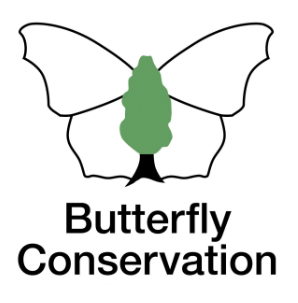Brown Argus
Brown Hairstreak
Chalkhill Blue
Clouded Yellow
Comma
Common Blue
Dark Green Fritillary
Dingy Skipper
Essex Skipper
Gatekeeper
Green Hairstreak
Green-veined White
Grizzled Skipper
Holly Blue
Large Skipper
Large White
Marbled White
Meadow Brown
Orange-tip
Painted Lady
Peacock
Purple Emperor
Purple Hairstreak
Red Admiral
Ringlet
Silver-washed Fritillary
Small Blue
Small Copper
Small Heath
Small Skipper
Small Tortoiseshell
Small White
Speckled Wood
Wall
White Admiral
White-letter Hairstreak
Extinct/rare immigrants
Painted Lady
Vanessa cardui
General Distribution and Status
The Painted Lady is a summer visitor found throughout Britain but its numbers fluctuate widely each year. Unfortunately, it does not appear to survive our winters. Like the Red Admiral, its numbers have more than doubled since the 1970s but a slight decline since 2007 in spite of the huge invasion in 2009 (Brereton et al.)! The big influx in 2009 occurred so quickly and many specimens would have been missed on transects during the Spring Bank Holiday. The subsequent brood was relatively small. Adults originate from north Africa and some theories have been suggested on what triggers migration. For most species, when populations reach a certain density (carrying capacity) at a breeding site some individuals will disperse to find a new one. For the Painted Lady if populations are overwhelmingly high the degree of dispersal is so great it is no surprise that migration, as usually understood, could take place. Environmental conditions play a role, too. In spring, weather in north Africa is probably too hot and dry for the butterfly to survive without healthy hostplants to breed and flowers to feed on. A reverse southward migration in the autumn also occurs but the butterflies mostly fly at much higher altitudes so far fewer sightings of this event are recorded (Fox 2009). In the winter of 2012-13 Painted Ladies were arriving on our shores on New Year's Day (Fox & Bowles). In Hertfordshire and Middlesex, overall abundance has declined since the mid 1990s although there were good years in 2003, 2006 and 2009 (Wood, 2016). 2019 was also a Painted Lady year although there were unusually far more reports in the north-east of the country.
| United Kingdom | Herts & Middx | |||
| Distribution | 1976-2019 | +18% | 1980-2015 | -5% |
| Average 10-year trend | +3% | 2006-2015 | -25% | |
| 2024 since 2015-19 | -30% | |||
| Abundance | 1976-2024 | +66% | 1980-2015 | -91% |
| 2015-2024 | -54% | 2006-2015 | -87% | |
| 2023-2024 | -46% | 2024 since 2015-19 | -75% | |
UK distribution map
UKBMS Species summary
Habitat Requirements
Being a mobile species it can be seen in every habitat type but it is perhaps most abundant in fields where there are thistles. Not only are thistles the main larval foodplants but also good nectar sources.
Larval Foodplants
Thistle Carduus spp. and Cirsium spp. Musk Thistle Carduus nutans is probably the favoured plant on dry calcareous soils. Stinging Nettle Urtica dioica, Mallow Malva spp., Burdock Arctium spp. and Viper's Bugloss Echium vulgare are other foodplants sometimes selected (Sawford).
Adult Food Sources
Buddleia Buddleja davidii (704), Red Valerian Centranthus ruber (167), Iceplant Sedum spectabile (78).
Historical Records
The first record mentioned for the Stevenage area was by Herbert Matthews around 1900 (Gibbs 1902). (Gibbs 1904) in his report for 1903 writes 'one of the worst seasons on record - long continued spell of cold and wet weather. Fine weather in early October produced influx of Painted Ladies which were of a much lighter colour than usual'. Foster's 1937 report refers to it as 'recorded from all districts; common in some years'. There was an early spring influx in 1952 but the cold and the snow in late March seemingly killed off most of the visitors (Bell 1953). 1958, 1962, 1969, 1972 and 1980 were good years (Bell 1959, 1964, 1970, 1973 and Waterton).
Local Distribution and Abundance
As indicated on the map, the butterfly is well distributed in the Stevenage area. The best year in terms of abundance in the area was in 2006 when high numbers were reported in late July and early August: 100 at Great Ashby Park on 24 July and 89 at Fairlands Valley Park on 29 July. The best count, though, was 128 on 6 August 2009 at Great Ashby Park. More than 100 reports came in for 2019, easily the highest on record, but none yielded more than eight individuals. Only 14 reports were received in 2024 and two of those were for specimens seen in October, unusually late in the season.

Stevenage (South Fairlands Valley Park) transect 1993-2025
No significant trend can be discerned from the graph although it appears to be on a small downward spiral with very few individuals since 2006, the best year with 143 counted. Even in 2009 only 10 were recorded in all with just three on 28 May, three days after Spring Bank Holiday!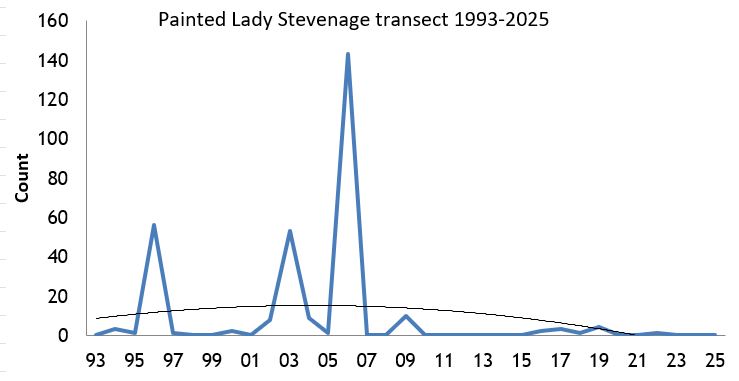
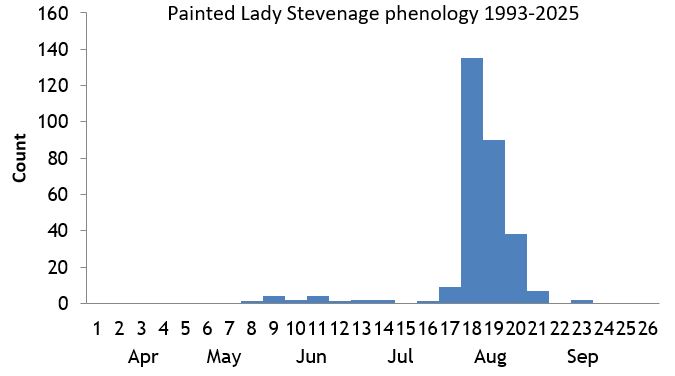
Knebworth Park transect 1996-2010 and 2017-2025
Unsurprisingly, 2009 was the best year but the main influx was missed when the transect was walked on 29 May with three specimens reported. However, the best count during the survey was achieved on 30 July 2006 when 20 individuals were recorded. Since the resumption of the transect in 2017, the best year was 2019 with seven sightings.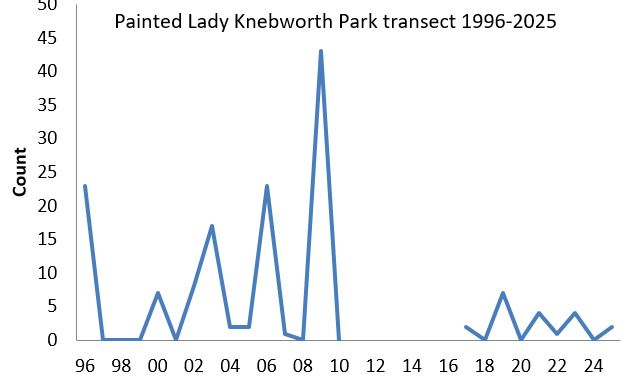
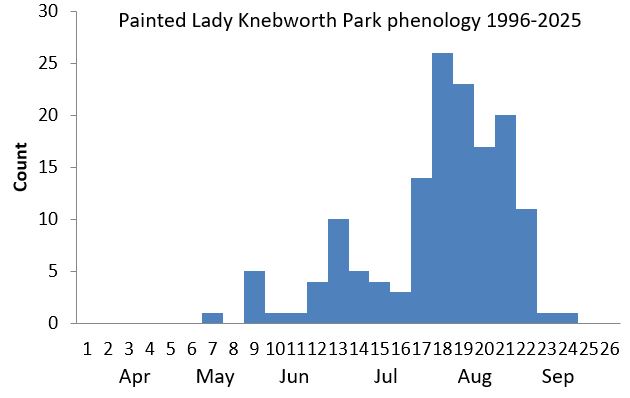
Knebworth Woods transect 2017-2025
11 specimens were reported including five in 2019.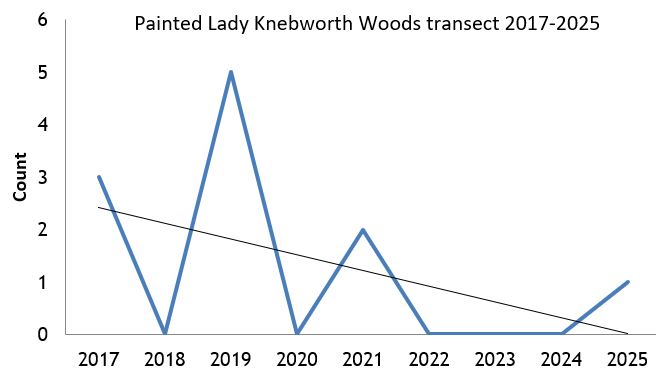
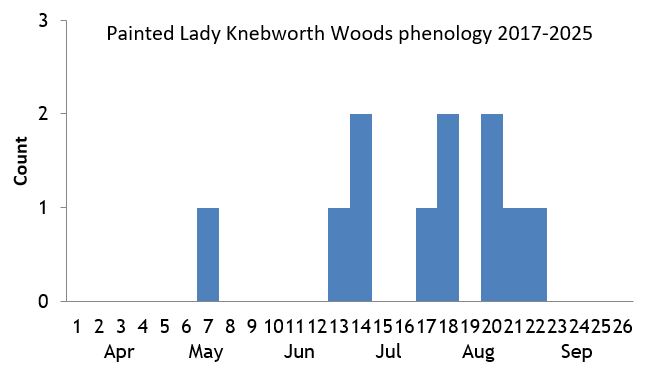
Pryor's Wood transect 2000-2022
The Painted Lady was seen in each of the following years: 2007, 2008, 2009, 2010 and 2021. The highest count was achieved on 8 August 2009 when eight were seen.Life History
Earliest date: 11 May 2009 at Chells Manor
Latest date: 23 October 2009 at Roebuck
The Painted Lady usually
starts arriving here in April, with several generations produced throughout the summer augmented by more immigrants from the continent. In September and
October, some individuals may be observed emigrating in a southerly direction. Eggs are laid singly on the foodplant often on the leaf upperside. Larvae hatch out
usually after about a week and form silk tents under the leaves. Pupae are formed within these tents.
Behaviour/Observation notes
The best time to look for the Painted Lady is in August in gardens and waste ground where thistles are in flower. In the spring, look for it feeding on willow flowers (Riley).
Variations/Aberrations
Variations in the markings and the ground colour have been found but are probably rare. One unusual form was found at Church Fields, Harrow on the Hill
in 2016 by Allan Lunn where the pink/orange ground colour was replaced by almost white; this could be the aberration ab. pallens
(Wood 2017). The pale colouring and the smaller size of specimens found in early October 1903 as noted above could be classed as an aberration but
without enough detail it will have to remain unclassified.
Find out more on the UK Butterflies website
References
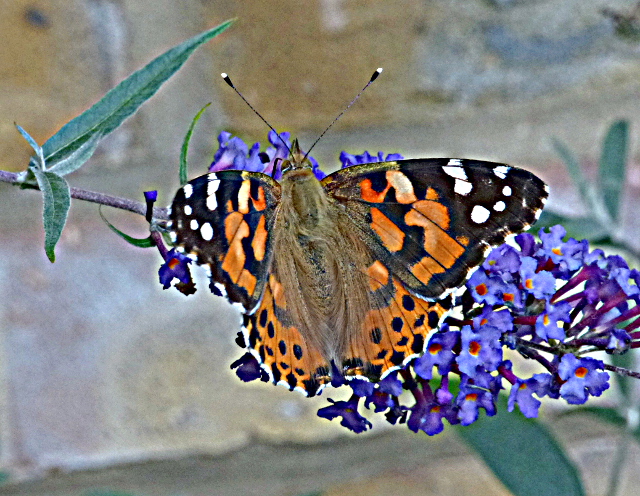
Garden 12 Aug 2017
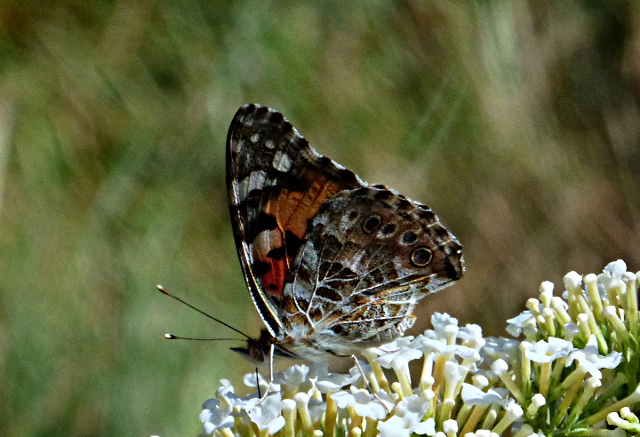
Garden 24 Aug 2016
